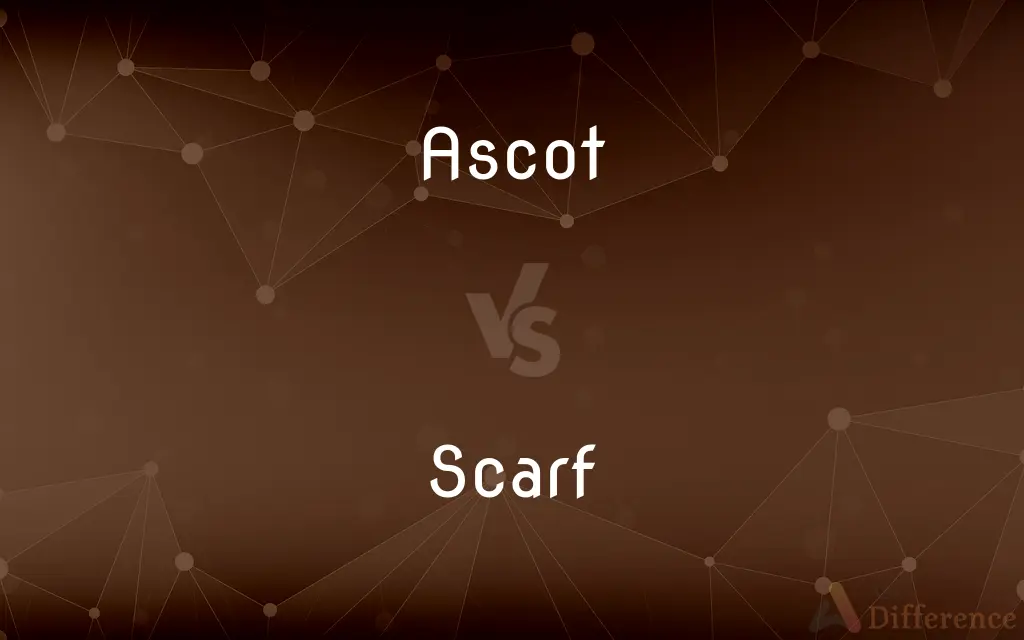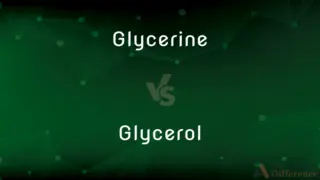Ascot vs. Scarf — What's the Difference?
By Tayyaba Rehman & Urooj Arif — Updated on April 22, 2024
An ascot is a formal cravat worn primarily by men for dress occasions, whereas a scarf is a versatile piece of fabric worn around the neck for warmth or style.

Difference Between Ascot and Scarf
Table of Contents
ADVERTISEMENT
Key Differences
The ascot is a type of neckwear that serves as a formal alternative to a tie, usually made from silk and worn with a pin. On the other hand, a scarf can be made from various materials like wool, cotton, or synthetic blends and is designed for functionality or fashion.
Traditionally, ascots are associated with upper-class attire and are often seen at weddings, formal events, or horse races. In contrast, scarves are ubiquitous and worn by people of all ages and social statuses in a variety of settings.
Ascots are typically patterned and secured with a decorative pin, contributing to a sophisticated and polished look. Scarves, however, come in countless styles and patterns and can be tied in numerous ways, from simple loops to intricate knots.
While ascots are mostly worn by men, scarves are gender-neutral and embraced universally as a practical accessory for warmth or a fashionable item to enhance an outfit.
Ascots reflect a very specific cultural significance, often perceived as a symbol of old-world elegance in Western fashion. Conversely, scarves are a global accessory with historical roots in many cultures and climates, reflecting a wide array of uses and styles.
ADVERTISEMENT
Comparison Chart
Material
Primarily silk
Wool, cotton, silk, synthetic, and others
Formality
High, used in formal settings
Ranges from casual to formal
Gender Association
Predominantly male
Gender-neutral
Cultural Significance
Strong, traditional Western fashion
Global, with diverse historical roots
Ways of Wearing
Tied in a specific knot and often pinned
Worn in various styles and knots
Compare with Definitions
Ascot
Often secured with a stickpin or tie tack.
He fastened his ascot with a vintage gold pin.
Scarf
A length of fabric worn around the neck or head for warmth, sun protection, or fashion.
She wrapped a silk scarf around her neck to add color to her outfit.
Ascot
Represents a high social status and traditional style.
The character in the play wore an ascot to signify aristocracy.
Scarf
Versatile in style, can be draped or knotted in various ways.
He used a simple loop knot to secure his scarf against the breeze.
Ascot
Limited to specific occasions like weddings or official gatherings.
Ascots are preferred at formal events in Europe.
Scarf
Can be made from a variety of materials, including wool, linen, and silk.
His wool scarf kept him warm in the winter chill.
Ascot
A neckband with wide pointed wings, traditionally made of pale grey patterned silk.
He chose an elegant ascot for the morning wedding.
Scarf
Available in countless colors and patterns.
She collected scarves, each with a unique pattern and story.
Ascot
Worn primarily in formal settings as part of morning dress.
His ascot was perfectly knotted for the royal ascot event.
Scarf
Worn by all genders and ages as a functional or stylish accessory.
The children wore bright scarves on their snow day.
Ascot
A town in southern England, south-west of Windsor. Its racecourse is the site of an annual race meeting.
Scarf
A scarf, plural scarves, is a piece of fabric worn around the neck or head for warmth, sun protection, cleanliness, fashion, or religious reasons or used to show the support for a sports club or team. They can be made in a variety of different materials such as wool, linen, silk or cotton.
Ascot
A broad neck scarf knotted so that its ends lie flat, one upon the other.
Scarf
A length or square of fabric worn around the neck or head
A silk scarf
She tucked her woolly scarf around her neck
Ascot
Ellipsis of ascot tie
Scarf
A joint connecting two pieces of timber or metal in which the ends are bevelled or notched so that they fit over or into each other.
Ascot
A cravat with wide square ends, tied so that the ends are laid flat; the ends are often secured with an ornamental pin; - called cravat in Britain.
Scarf
An incision made in the blubber of a whale.
Ascot
A cravat with wide square ends; secured with an ornamental pin
Scarf
Join the ends of (two pieces of timber or metal) by bevelling or notching them so that they fit over or into each other
He forced me to scarf the keel timbers in watertight sections
The scarfing follows the natural grain of the wood
Scarf
Make an incision in the blubber of (a whale).
Scarf
Eat or drink (something) hungrily or enthusiastically
He scarfed down the waffles
Scarf
A long piece of cloth worn about the head, neck, or shoulders.
Scarf
A decorative cloth for covering the top of a piece of furniture; a runner.
Scarf
A sash indicating military rank.
Scarf
A joint made by cutting or notching the ends of two pieces correspondingly and strapping or bolting them together. Also called scarf joint.
Scarf
Either of the correspondingly cut or notched ends that fit together to form such a joint.
Scarf
To dress, cover, or decorate with or as if with a scarf.
Scarf
To wrap (an outer garment) around one like a scarf.
Scarf
To join by means of a scarf.
Scarf
To cut a scarf in.
Scarf
To eat or drink voraciously; devour
"Americans scarf down 50 million hot dogs on an average summer day" (George F. Will).
Scarf
A long, often knitted, garment worn around the neck.
Scarf
A headscarf.
Scarf
(dated) A neckcloth or cravat.
Scarf
A type of joint in woodworking.
Scarf
A groove on one side of a sewing machine needle.
Scarf
A dip or notch or cut made in the trunk of a tree to direct its fall when felling.
Scarf
(Scotland) A cormorant.
Scarf
To throw on loosely; to put on like a scarf.
Scarf
To dress with a scarf, or as with a scarf; to cover with a loose wrapping.
Scarf
To shape by grinding.
Scarf
To form a scarf on the end or edge of, as for a joint in timber, forming a "V" groove for welding adjacent metal plates, metal rods, etc.
Scarf
To unite, as two pieces of timber or metal, by a scarf joint.
Scarf
To eat very quickly.
You sure scarfed that pizza.
Scarf
A cormorant.
Scarf
An article of dress of a light and decorative character, worn loosely over the shoulders or about the neck or the waist; a light shawl or handkerchief for the neck; also, a cravat; a neckcloth.
Put on your hood and scarf.
With care about the banners, scarves, and staves.
Scarf
In a piece which is to be united to another by a scarf joint, the part of the end or edge that is tapered off, rabbeted, or notched so as to be thinner than the rest of the piece.
Scarf
To throw on loosely; to put on like a scarf.
Scarf
To dress with a scarf, or as with a scarf; to cover with a loose wrapping.
Scarf
To form a scarf on the end or edge of, as for a joint in timber, metal rods, etc.
Scarf
A garment worn around the head or neck or shoulders for warmth or decoration
Scarf
A joint made by notching the ends of two pieces of timber or metal so that they will lock together end-to-end
Scarf
Masturbate while strangling oneself
Scarf
Unite by a scarf joint
Scarf
Wrap in or adorn with a scarf
Common Curiosities
What is a scarf?
A scarf is a piece of fabric worn around the neck or head for warmth, protection, or fashion, made from various materials.
Are ascots still fashionable?
Yes, ascots are considered fashionable within certain circles and occasions that appreciate a vintage or formal aesthetic.
What are some cultural significances of scarves?
Scarves have various cultural significances, including religious and traditional uses in many parts of the world.
What is an ascot?
An ascot is a type of necktie usually made of silk, characterized by wide pointed wings, typically worn in formal settings.
How can scarves be styled?
Scarves can be styled in numerous ways, including loops, knots, or drapes, depending on the wearer’s preference.
When is an ascot worn?
Ascots are usually worn for formal events, such as weddings or traditional morning dress occasions.
Is there a gender preference for wearing ascots?
Traditionally, ascots are worn by men, especially in very formal or traditional settings.
What differentiates a scarf from an ascot in terms of design?
Ascots have a specific shape and are generally made of silk, designed for formal wear, whereas scarves are more versatile and come in various shapes and materials.
Can scarves be worn in all seasons?
Yes, scarves can be worn in all seasons, with material and style adapted to weather conditions—lighter fabrics like silk for summer and heavier wools for winter.
How do you tie an ascot?
An ascot is tied in a special knot that lies flat and wide, often secured with a decorative pin.
What materials are commonly used to make scarves?
Scarves are made from a variety of materials, including wool, cotton, silk, and synthetic fibers.
Can ascots be casual?
While primarily formal, ascots can be styled in a more casual manner, especially within contemporary fashion trends.
Are scarves a practical accessory?
Yes, scarves serve practical purposes such as warmth and protection from the sun, in addition to being fashionable.
Can ascots be part of a daily wardrobe?
Generally, ascots are not part of a daily wardrobe due to their formal nature but may be incorporated into fashion-forward or artistic outfits.
Why might someone choose to wear a scarf over an ascot?
Scarves offer greater versatility, practicality, and accessibility in terms of style, material, and usage compared to the more formal and less versatile ascot.
Share Your Discovery

Previous Comparison
Total vs. Tally
Next Comparison
Glycerine vs. GlycerolAuthor Spotlight
Written by
Tayyaba RehmanTayyaba Rehman is a distinguished writer, currently serving as a primary contributor to askdifference.com. As a researcher in semantics and etymology, Tayyaba's passion for the complexity of languages and their distinctions has found a perfect home on the platform. Tayyaba delves into the intricacies of language, distinguishing between commonly confused words and phrases, thereby providing clarity for readers worldwide.
Co-written by
Urooj ArifUrooj is a skilled content writer at Ask Difference, known for her exceptional ability to simplify complex topics into engaging and informative content. With a passion for research and a flair for clear, concise writing, she consistently delivers articles that resonate with our diverse audience.
















































